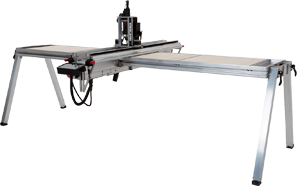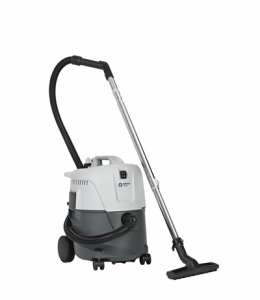Essential principles - Extraction
Home » Knowledge Base » SmartBench Knowledge Base » Essential principles » Extraction
Routing naturally produces swarf, and without proper extraction this swarf can start to build up on the surface of the workpiece.
Poor extraction and build up of swarf on the workpiece can cause:
High levels of friction and heat at the cutting site.
Reduced finished part accuracy.
Loss of position mid-job.
Blunting of the cutter.
Job failure.
To remove swarf during operation, SmartBench uses air-extraction.
It is critical that swarf is removed from the cutting site during the machining operation by an effective extractor. |
A: Swarf
Flow rate, measured in litres per second (l/s), is the amount of air that flows through the vacuum in one second.
For your SmartBench you will need a MINIMUM flow rate of 50 l/s.
Some materials and applications WILL require extractors with a higher flow rate. Consider your application when choosing an extractor! |
How to check that the extractor’s flow rate is high enough during a job
A flow rate of 50 l/s will be enough for most applications. However, it is still a good idea to do a visual inspection of how well your extraction is performing.
The flow rate is high enough if you can see that there is no swarf or dust on the worktop during and after machining.
Overview
The extractor can be powered either from:
SmartBench, or
a separate power outlet
Powering your extractor from SmartBench is useful, since SmartBench can then automatically switch the extractor on and off.
However, the power supply cable to your SmartBench (shown above in red) may not be able to carry the extra load of the extractor. This depends on:
The size of your extractor.
Your operating voltage.
The current rating of the power cable supplying SmartBench (which will depend on your region).
If your power supply cable to SmartBench is unable to support the extra load of your extractor, your extractor will need to be powered from a separate power outlet. |
How to work out if SmartBench can power your extractor
Step 1: Check your extractor power rating
Look for the extractor power rating specified by the manufacturer, and make a note of it. This should be stated on the electrical specification label found on the extractor itself.
For example, the extractor shown here has the power rating of 1200 W:
Step 2: Identify what voltage your SmartBench uses
Make a note of this value as well. Click here if you are not sure how to check what voltage your SmartBench uses.
The SmartBench in this image uses a 230 V input:
Step 3: Check your power supply cable
If you are using the standard power cable supplied with SmartBench plugged into a mains outlet, you just need to know which geographical region it’s for (most likely, the region you’re currently in).
If you are using a custom set up to power SmartBench, you will need to make a note of the current rating for your specific power cable or set up.
Step 4: Work out the maximum power remaining for extraction
The last step is to work out how much remaining power is available in the SmartBench set up, and whether it is enough to power your extractor.
If the maximum power remaining for extraction is less than the power rating of the extractor, you will need to plug it into an external power source. |
If you are using a standard power setup (i.e. the provided power cables and a mains power supply), you can simply read the values from this lookup table:
Maximum power (W) available for an extractor, if powered from SmartBench | ||
Power cable region | 120V SmartBench | 230V SmartBench |
UK | 149 | 1578 |
USA/Can | 389 | 2038 |
EU | 509 | 2268 |
Aus/NZ | 389 | 2038 |
Look at the bottom appendix if you are using a custom set up, and need to do your own calculations for your extractor power requirements. |
Worked example: An example workshop in the USA
For a particular workshop in the USA:
Voltage is 120 V
Mains cable to SmartBench is for the USA/Can region (rated at 15 A)
Extractor has a power rating of 1200 W
The table says this workshop could use an extractor up to 389 W.
Maximum power (W) available for an extractor, if powered from SmartBench | ||
Power cable region | 120V SmartBench | 230V SmartBench |
UK | 149 | 1578 |
USA/Can | 389 | 2038 |
EU | 509 | 2268 |
Aus/NZ | 389 | 2038 |
Since the extractor is 1200 W, it will draw too much current from SmartBench’s extraction power outlet. It will therefore need to be powered by an external source.
Worked example: An example workshop in the UK
For a particular workshop in the UK:
Voltage is 230 V
Mains cable to SmartBench is rated for the UK region (rated at 13 A)
Extractor has a power rating of 1200 W
The table says this workshop could use an extractor up to 1578 W.
Maximum power (W) available for an extractor, if powered from SmartBench | ||
Power cable region | 120V SmartBench | 230V SmartBench |
UK | 149 | 1578 |
USA/Can | 389 | 2038 |
EU | 509 | 2268 |
Aus/NZ | 389 | 2038 |
Since the extractor is 1200 W, it is within the limit of what we can power from this SmartBench setup.
Setting up your extraction configuration
If powering your extractor from SmartBench:
The extractor plugs into the extraction power lead coming from SmartBench. Click here to learn more about this.
This is the wiring diagram:
If powering your extractor from a separate power outlet:
Both your extractor and SmartBench will be plugged into an external source, such as a wall power outlet. Click here to learn more about this.
This is the wiring diagram:
A: Extractor power cable
B: SmartBench power cable
Appendix A: Supplied SmartBench power cable ratings
This is the current rating for your supplied power cable, depending on your region:
UK | 13 A |
USA/Can | 15 A |
EU | 16 A |
Aus/NZ | 15 A |
Appendix B: How to calculate power requirements
In the following equations and examples, we are looking to work out the maximum power remaining for extraction, which is measured in Watts (W).
In order for SmartBench to be able to power the extractor, the extractor power rating has to be less than the maximum power remaining for extraction. If it is not, the extractor will need to be powered by an external source.
Assume that all currents input into our calculation are measured in Amps (A), and any voltages are measured in Volts (V).
Equation for a 120V SmartBench
(power cable current rating – 11.76) x 120 = maximum power remaining for extraction
Equation for a 230V SmartBench
(power cable current rating – 6.14) x 230 = maximum power remaining for extraction
Worked examples
Worked example 1: A particular workshop in the USA
For a particular workshop in the USA:
Voltage is 120 V
Mains cable to SmartBench is rated at 15 A
Extractor has a power rating of 1200 W
We’ll choose the equation for a 120V SmartBench:
(power cable current rating – 11.76) x 120 = maximum power remaining for extraction
We’ll plug our numbers into our equation:
maximum power remaining for extraction = (15 – 11.76) x 120
Do the calculation inside the brackets, (15 – 11.76 = 3.24):
maximum power remaining for extraction = (3.24) x 120
Do the final multiplication:
maximum power remaining for extraction = 388 W
Now, we can compare the maximum power remaining for extraction to the actual power rating of our extractor:
maximum power remaining for extraction = 388 W
extractor power rating = 1200 W
extractor power rating > maximum power remaining for extraction
The extractor uses more power than SmartBench can supply, so we’ll need to connect it to an external supply. Click here to learn more about this.
Worked example 2: A particular workshop in the UK
For a particular workshop in the UK:
Voltage is 230V
Mains cable to SmartBench is rated at 13A
Extractor has a power rating of 1200 W
We’ll choose the equation for a 230V SmartBench:
(power cable current rating – 6.14) x 230 = maximum power remaining for extraction
We’ll plug our numbers into our equation:
maximum power remaining for extraction = (13 – 6.14) * 230
Do the calculation inside the brackets, (13 – 6.14 = 6.86):
maximum power remaining for extraction = (6.86) * 230
Do the final multiplication:
maximum power remaining for extraction = 1600 W
Now, we can compare the maximum power remaining for extraction to the actual power rating of our extractor:
maximum power remaining for extraction = 1600 W
extractor power rating = 1200 W
extractor power rating < maximum power remaining for extraction
The extractor uses less power than SmartBench has available, so we can power the extractor directly from SmartBench. Click here to learn more about this.
What type of extractor should I use?
Choose a shop vacuum
You need a system that is able to remove large chips from the SmartBench worktop.
Shop vacs are perfect for SmartBench, as they are designed to pick up a range of heavy debris (such as chips and swarf) from a small space (i.e., the cutting site).
They are also designed to collect waste from a range of materials (not just wood).
What about dust extraction?
Ideally, choose at least an M (Medium) Class shop vacuum that is designed to pick up most dust particles.
This is to protect your lungs from unseen dust, and may also be a health and safety requirement for your extraction system if you are working on site.
A quick note on “dust extractors”: Dust extractors are primarily designed to remove wood dust particles from larger spaces. They are not necessarily designed to collect other materials or sharp debris, and could be damaged by them. Despite having high rates of airflow, they might not have the high pressure required to lift chips and swarf from the worktop. If you are considering a dust extractor, always check the tech specs! |
Materials
Different materials will come with different extraction requirements (e.g., MDF produces a lot of fine dust compared to plywood). Consider what materials you will be cutting when you choose an extractor.
Bag or bagless?
You can choose an extractor that uses a bag, or not, depending on your needs.
Pros | Cons | |
Bag | Easier to empty waste out of the extractor. | Suction will decrease as the bag fills. |
Bagless | Suction won’t decrease as the extractor fills. | Harder to remove waste; involves lifting and tipping the entire extractor. |
Capacity
We recommend a minimum capacity of 27 litres, or 6 gallons.
Consider portability
It might sound obvious, but if you are intending to move SmartBench from site to site, your extraction set up will need to be portable too!
If SmartBench is likely to stay in one place, you might consider a larger and more powerful extraction system.
Check the dimensions and weight of extractors to make sure they are right for you.
Power rating
SmartBench can automatically control your extraction system, providing it meets SmartBench’s power requirements.
The power requirements vary depending on your region and your SmartBench, so go to the section prior to this to learn more.
Other features
Pay attention to the other features that extractors have, such as anti-clogging technology, overload or blockage warnings, and filters.
Domestic, heavy duty, commercial?
Regardless of how the extraction system is described, the best thing to do is check the technical specifications:
Can it meet the minimum requirements for flow rate?
What is its power rating?
Is it designed to pick up chips, swarf, and dust?
Don’t try to “make do” with your old domestic Henry Hoover! Domestic vacuums are not designed to pick up the high volumes or types of waste created by SmartBench, nor are they designed to run continuously for long periods of time. Using a domestic vacuum will damage both your work, and the vacuum. |
What size hose should I use?
Hose diameter
Extraction hoses come in many different sizes, and will have different properties as a result:
Smaller diameter hoses tend to be more maneuverable and flexible.
Larger diameter hoses can pick up bigger debris, and are less likely to clog.
The size of the hose affects the rate of airflow: decreasing the hose diameter will also decrease the rate of airflow.
SmartBench’s in-built hose has an outer diameter of 38mm.
Recommended minimum hose diameter | |
Inner diameter (ID) | 32mm |
Outer diameter (OD) | 38mm |
You can work out how much a change in hose size will affect your flow rate. The flow rate is proportional to the inner radius of the hose to the fourth power. If you want to work out what your new flow rate (Fnew) would be if you changed the radius of your hose (Rold to Rnew), you can use this equation*: *From the Hagen–Poiseuille law. |
Hose length
The longer a hose of an extractor, the more air friction it encounters, reducing the rate of airflow.
For SmartBench, the hose length needs to be short enough that the extraction system still meets the minimum airflow rate requirement of 70 l/s (litres per second).
Keep the hose as short as possible, to maintain a high flow rate |
L: Hose length.
You can work out how much a change in hose length will affect your flow rate. The flow rate is inversely proportional to the length of the hose. If you want to work out what your new flow rate (Fnew) would be if you changed the length of your hose (Lold to Lnew), you can use this equation*: *From the Hagen–Poiseuille law. |
Hose fitting
The SmartBench extraction connector is compatible with connectors with an inner diameter of 27 mm.
Sucking swarf and dust through a plastic tube is a fantastic way to generate very high levels of static electricity.
As with all high-flow extraction, you should take steps to discharge the static electricity that will be generated from it. Discharging static electricity is easy to do and will prevent job failure.
Earthing is an important consideration for all extraction systems, and especially those with higher flow rates.
Allowing static to build to high levels can cause SmartBench to reset in mid operation. At best this will cause job failure, and worst it can damage the electronics. |
How is static electricity generated?
If a material rubs against another material, particles of electric charge (electrons) can be physically transferred from one material to another.
If one of these materials is an electrical insulator (e.g. extraction hose material) and not earthed, the charge that is transferred is unable to flow anywhere else. Instead, it builds up on the surface of the material.
It’s called “static electricity” because the charge is unable to move away or discharge. |
Why does your extraction build up static electricity?
As swarf and dust particles flow up the plastic tube, they will rub against each other and the tube, transferring charge and quickly creating a cloud of static electricity.
If there is no discharge path in the extraction system, this static cloud can build to thousands or even tens of thousands of volts.
What makes static build up worse?
Higher airflow rate: more particles will travel through the hose every second, meaning more opportunities for them to rub together and transfer charge.
Longer hose length: the extra distance to the extractor tank means more opportunity for the particles to rub, resulting in a bigger difference in charge between sections of the hose.
Smaller hose diameter: reducing the diameter of the hose results in a higher surface area to volume ratio for a given volume of air. This means that more air and particles will be in contact with the inner surface of the hose, transferring charge.
What happens when too much static electricity builds up?
Allowing static to build to high levels can lead to it suddenly and dangerously discharging. At best this will cause job failure, and worst it can damage the electronics.
What is an ESD?
ESD stands for Electrostatic discharge.
A static cloud is always looking to discharge or flow to earth.
For example, when your skin is charged with static electricity and you touch something metal, like a door handle, the metal is very conductive and will quickly discharge the static electricity. You will feel this as a small shock.
If the static cloud has a higher voltage, it has more intrinsic energy, and that can enable it to “jump”. A larger (i.e. higher voltage) static cloud can jump over larger distances.
Photo by Mike Lewinski on Unsplash
In the case of the unearthed vacuum tube, the static can build to such a high level that the voltage will eventually jump to an earthed piece of metal (typically on SmartBench or on the extractor). But by this time the cloud could have reached tens of thousands of volts. And that’s a problem…
Why is a large ESD bad?
During an ESD event , a wave of electromagnetic energy is released (also known as an EMP). If it’s large enough, it’s very effective at knocking out electronics.
Typically a large ESD charge will either stop the electronics from working temporarily, or cause permanent damage.
For SmartBench, we are able to prevent permanent damage in most cases, but a large ESD will cause the real-time electronics to reset. If SmartBench is in mid-job, this will cause the job to fail.
How to prevent large ESDs
The solution to prevent ESDs is to put an earthing path (a conductor linked to ground) along the area where static would build up. This means that the cloud can quickly discharge as it begins to accumulate, preventing high voltage static clouds and big ESDs.
How to prevent the accumulation of static electricity in your extraction system
Best practice is to attach an exposed conductor (metal wire) along the length of the extraction tube, which is plugged into an earthing point. This creates a flow path for the negatively charged static to run to ground.
When you have earthed your extraction system and tubing, you will no longer have to worry about static.
You can only operate your extractor from the console if it is powered by SmartBench.
Look at the section ‘Choosing how to power your extractor’ find out if your extractor meets SmartBench’s power requirements, and how to connect it to SmartBench.
Extractor setup
Make sure the extractor is connected to SmartBench and its power switch is set to on.
A: Extraction power switch
Switching the extractor on and off at the start and end of each job.
You don’t need to do anything for this. SmartBench will automatically turn the extractor on at the start of a job, and off at the end.
SmartBench will check to see if the spindle comes on during the job to determine whether extraction is needed. If there is no spindle command in the job file, it won’t turn on the extraction. |
Switching the extractor on from the Console
In the Console menu, click on the “Pro” App
Click on the manual move tab on the left side of the screen.
Once on the manual move screen, you can toggle extraction on and off as you need.
You can check that everything is connected and switched on at the start of a job by toggling the extraction and spindle buttons on the Console. |



